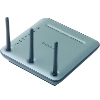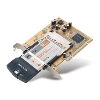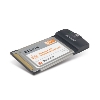
| Pre-N Wireless Hardware Roundup |
Introduction
When we started this roundup, we quickly became quite surprised at how few manufacturers are currently pushing "pre-n" ranges of hardware. Whilst almost all of them had added 802.11n features such as mimo and range/speed extending technologies to their existing ranges, many had removed all mention of "pre-n" from both their websites and product lines.Only Belkin appeared to be actively pushing their "pre-n" range of wireless hardware, while previous advertised (and award winning) pre-n hardware had dissappeared from Negear's lineup. We can only assume that the manufacturers are removing any mention of "pre-n" in readiness for the launch of "N" hardware as soon as the specification is ratified. Alternatively are consumers becoming confused or apathetic towards the growing range of wireless options (a,b,g,n,bluetooth and soon wimax)?
Belkin
Belkin were the only manufacturer we could find that was still offering a full range of "pre-n" wireless hardware, (router,pci card and pccard) and given their 'sold out' status at many sites, seem to be selling well.
| Manufacturer | Type | Model | Picture |
| Belkin | Router | Wireless Pre-N Router F5D8230-4 |  |
| Belkin | Desktop Network Card | Wireless Pre-N Desktop Card F5D8000 |  |
| Belkin | Notebook Network Card | Wireless Pre-N Notebook Card F5D8010 |  |
Netgear
Only their pccard appears to still be available even though their router got good reviews and even won an award.
| Manufacturer | Type | Model | Picture |
| Netgear | Router | Pre-N Wireless Router WGM124 |  |
| Netgear | Router | Pre-N Wireless PC Card WGM511 |  |
Conclusion
Now that most manufactures have included 802.11n technology into their existing ranges, they seem to be focused on pushing their 802.11g products with new range and speed enhancing features. I'm sure that once the 802.11n specification is ratified we will start to see them delivering "n" products again, though how they will differentiate these from their enhanced 802.11g options is not clear.
| SAE | |
| I laughed when I realized the 802 series letter suffix is just like motor oil and SAE specifications. I have been changing my own oil since SAE rating SC or so, and we now are up to SH. Savvy consumers will simply look for the highest letter in the alphabet in years to come, unless of course marketing people get ahold of the nomenclature protocol, and come up with a new letter to help sales, not the technical specs. And why did they pick "n" rather than "h" or something logical? Running Windows 3.3 here, in case you're wondering. | |
| Posted 25 Jul 2006 by Paul | |
| 802.11 alphabet soup | |
| 802.11 is actualy alphabet soup and standards do exist from 802.11a to 802.11z. Some have not reached full standard form (e.g 802.11n is still a "pre" standard that has not been ratified or fully defined.) Some are reserved or not used. 802.11a/b/g/n standards actually have to do with changes in Mbps, RF (radio frequency) band and channel size. They get the most attention because of marketing. Most Manufacturers don't mention things like 802.11c spanning tree protocol for wireless (which used the 802.1D spec instead) or 802.11d which defined multiple regulatory domains or 802.11e QOS for wireless because they are more technical and less "marketing-friendly". Here is the alphabet soup: 802.11: The original 1 Mbit/s & 2 Mbit/s, 2.4 GHz RF & IR standard with 20MHz-wide channels 802.11a: 5GHz channels with 54/48/36/24/18/12/9/6 Mbps data rates 802.11b: added 5.5 and 11Mbps data rates to the original 802.11 spec 802.11c: adopted STP(802.1D) for wireless 802.11d: defined new regulatory domains 802.11e: Quality-of-Service for wireless 802.11f: inter access point protocol (rescinded; suggested practice only) 802.11g: added 54/48/26/24/18/12/9/6 Mbps data rates to 2.4GHz channels 802.11h: dynamic frequency selection and transmit power control for 5GHz (to avoid interfering with radar). 802.11i: Security enhancement to AES encryption, TKIP ciphers and 802.1x authentication 802.11j: 4.9 GHz - 5GHz Operation in alternate regulatory domain (Japan) 802.11k: Radio Resource Measurement enhancements 802.11l: (not used,could be confused with 802.11i) 802.11m/ 802.11ma: maintenance changes to 802.11a, 802.11b, 802.11b corrigendum 1, and 802.11d. 802.11n: Higher Throughput up to 624 Mbps using 40Mhz wide channels and MIMO antennas 802.11o: Not used. typologically unsound 802.11p: WAVE - Wireless Access for the Vehicular Environment (such as ambulances and passenger cars, rail and marine.)- Communication to and between vehicles operating at speeds up to a minimum of 200 km/h for up to 1000 meters in the 5.850-5.925 GHz (US) and 5GHz (non-US) bands 802.11q: (not used, typologically unsound, can be confused with 802.1Q VLAN trunking) 802.11r: Fast connectivity for VoIP in ESS (aka Fast roaming across APs for VoIP devices) 802.11s: Wireless Mesh for 802.11 systems including wireless path provisioning 802.11T: Wireless Performance Prediction (WPP) - test methods and metrics. This is a "recommended practice" and not a standard. 802.11u: Interworking with non-802 networks (e.g., cellular) 802.11v: Wireless network management of wireless client stations 802.11w: Protected Management Frames 802.11x: Reserved 802.11y: Contention Based Protocol for 3650-3700 MHz band in the USA. 802.11z: Reserved Status of 802.11 standards can be found here: http://grouper.ieee.org/groups/802/11/Reports/802.11_Timelines.htm | |
| Posted 20 Sep 2006 by Nate Hills | |
